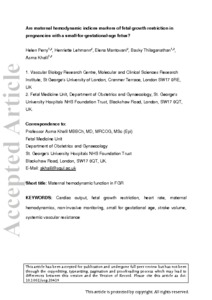Perry, H; Lehmann, H; Mantovani, E; Thilaganathan, B; Khalil, A
(2020)
Are maternal hemodynamic indices markers of fetal growth restriction in pregnancies with a small‐for‐gestational‐age fetus?
Ultrasound Obstet Gynecol, 55 (2).
pp. 210-216.
ISSN 1469-0705
https://doi.org/10.1002/uog.20419
SGUL Authors: Thilaganathan, Baskaran Khalil, Asma
![[img]](https://openaccess.sgul.ac.uk/111112/1.hassmallThumbnailVersion/uog.20419.pdf)  Preview |
|
PDF
Accepted Version
Available under License ["licenses_description_publisher" not defined].
Download (416kB)
| Preview
|
Abstract
Objective
Pregnancies complicated by fetal growth restriction (FGR) have a worse outcome than those with a small‐for‐gestational‐age (SGA) fetus. There is increasing evidence of a maternal cardiovascular role in the pathophysiology of FGR. We aimed to compare maternal hemodynamic indices between pregnancies complicated by FGR and those delivering a SGA neonate, using a non‐invasive device.
Methods
This was a prospective study of normotensive pregnancies complicated by FGR (defined as estimated fetal weight (EFW) < 3rd centile or Doppler evidence of impaired placental‐fetal blood flow), those with a SGA fetus (defined as EFW < 10th centile) and control pregnancies with an appropriately grown fetus. Assessment of maternal hemodynamics (heart rate (HR), cardiac output (CO), mean arterial pressure (MAP), systemic vascular resistance (SVR) and stroke volume) was performed using a non‐invasive device (USCOM‐1A®). Uterine artery (UtA) pulsatility index (PI) was measured using transabdominal ultrasound. Hemodynamic variables that are affected by gestational age and maternal characteristics were corrected for using device‐specific reference ranges. Comparison between groups was performed using the chi‐square test or the Mann–Whitney U‐test, as appropriate.
Results
A total of 102 FGR, 64 SGA and 401 control pregnancies, with a median gestational age of 36 weeks, were included in the analysis. Women with a pregnancy complicated by FGR and those with a SGA fetus were shorter and weighed less than did controls. Compared with controls, the FGR group had significantly lower median maternal HR (80 beats per min (bpm) vs 85 bpm; P = 0.001) and CO multiples of the median (MoM; 0.91 vs 0.98; P = 0.003), and higher median maternal MAP (90 mmHg vs 87 mmHg; P = 0.040), SVR MoM (1.2 vs 1.0; P < 0.001) and UtA‐PI MoM (1.1 vs 0.96; P < 0.001), but there was no significant difference in stroke volume MoM (1.0 vs 0.98; P = 0.647). Compared with the SGA group, the FGR group had a significantly lower median HR (80 bpm vs 87 bpm; P = 0.022), and higher median maternal MAP (90 mmHg vs 85 mmHg; P = 0.025), SVR MoM (1.2 vs 1.0; P = 0.002) and UtA‐PI MoM (1.1 vs 0.98; P = 0.005), but there was no significant difference in CO MoM (0.91 vs 0.96; P = 0.092) or stroke volume MoM (1.0 vs 1.0; P = 0.806). There were no significant differences in adjusted maternal hemodynamic indices between the SGA group and controls.
Conclusion
Pregnancies complicated by FGR presented with impaired maternal hemodynamic function, as evidenced by lower HR and CO, as well as higher MAP, SVR and UtA resistance. Pregnancies delivering a SGA neonate, without evidence of FGR, had normal maternal hemodynamic function. Maternal hemodynamic indices may therefore be of value in distinguishing FGR from SGA pregnancies.
| Item Type: |
Article
|
| Additional Information: |
This is the peer reviewed version of the following article: Perry, H., Lehmann, H., Mantovani, E., Thilaganathan, B. and Khalil, A. (2020), Are maternal hemodynamic indices markers of fetal growth restriction in pregnancies with a small‐for‐gestational‐age fetus?. Ultrasound Obstet Gynecol, 55: 210-216, which has been published in final form at https://doi.org/10.1002/uog.20419. This article may be used for non-commercial purposes in accordance with Wiley Terms and Conditions for Use of Self-Archived Versions. |
| Keywords: |
Cardiac output, fetal growth restriction, heart rate, maternal hemodynamics, non-invasive monitoring, small for gestational age, stroke volume, systemic vascular resistance, 1114 Paediatrics And Reproductive Medicine, Obstetrics & Reproductive Medicine |
| SGUL Research Institute / Research Centre: |
Academic Structure > Molecular and Clinical Sciences Research Institute (MCS) |
| Journal or Publication Title: |
Ultrasound Obstet Gynecol |
| ISSN: |
1469-0705 |
| Language: |
eng |
| Publisher License: |
Publisher's own licence |
| PubMed ID: |
31381215 |
| Dates: |
| Date |
Event |
| 2020-02-03 |
Published |
| 2019-08-05 |
Published Online |
| 2019-07-29 |
Accepted |
|
 |
Go to PubMed abstract |
| URI: |
https://openaccess.sgul.ac.uk/id/eprint/111112 |
| Publisher's version: |
https://doi.org/10.1002/uog.20419 |
Statistics
Item downloaded times since 20 Aug 2019.
Actions (login required)
 |
Edit Item |



